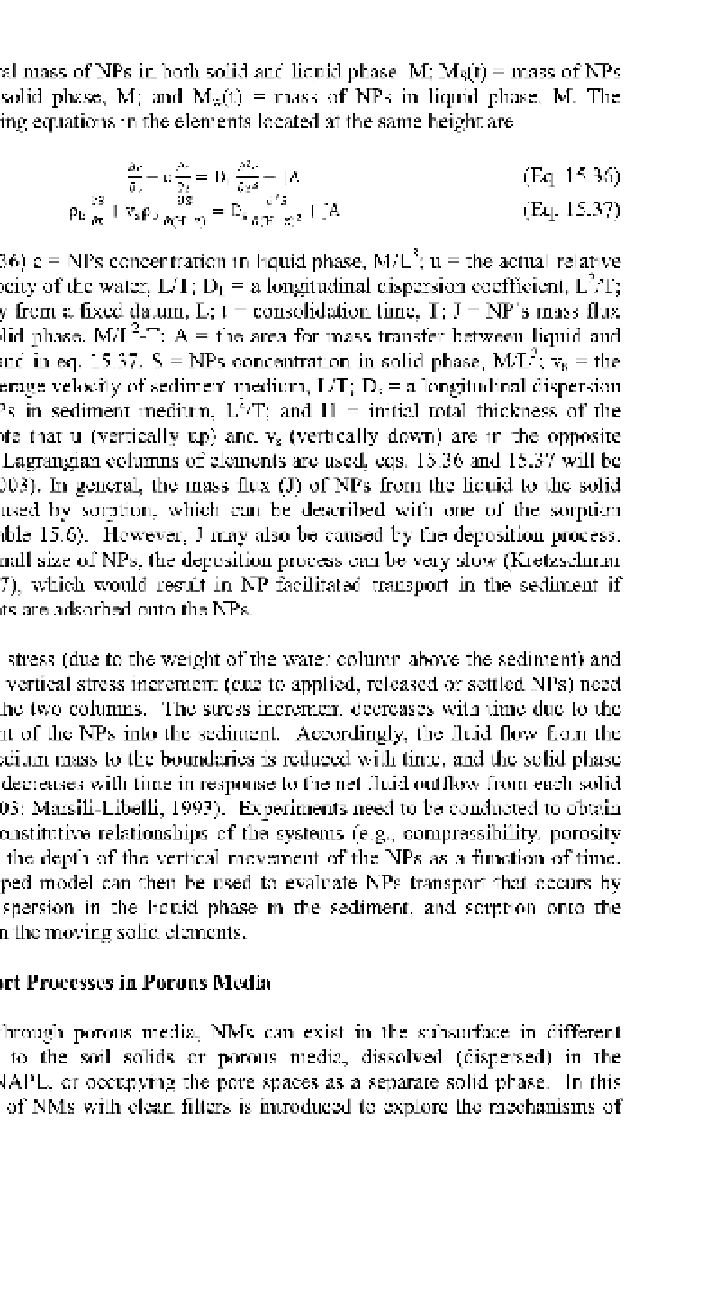Environmental Engineering Reference
In-Depth Information
where, M(t) = total mass of NPs in both solid and liquid phase. M; Ms(t) = mass of NPs
adsorbed to the solid phase, M; and M
w
(t) = mass of NPs in liquid phase, M. The
important governing equations in the elements located at the same height are
^
d
2
c
,
.
/-i-i
1 r- i /^\
dc
dc
L
dz
2
'
^
"
'
— + u— = D
L
— - JA
dz
(Eq. 15.36)
P^
+
V
^=
D
S
I + I
A
3t
(Eq. 15.37)
d
2
s
,
.
/-i-i
1 r- i
rj\
ds
ds
^
where (in eq. 15.36) c = NPs concentration in liquid phase, M/L
3
; u = the actual relative
average pore velocity of the water, L/T; DL = a longitudinal dispersion coefficient, L
2
/T;
z = distance away from a fixed datum, L; t = consolidation time, T; J = NP's mass flux
from liquid to solid phase, M/L
2
-T; A = the area for mass transfer between liquid and
solid phase, L
2
; and in eq. 15.37, S = NPs concentration in solid phase, M/L
3
; v
s
= the
actual relative average velocity of sediment medium, L/T; D
s
= a longitudinal dispersion
coefficient of NPs in sediment medium, L
2
/T; and H = initial total thickness of the
sediment, L. Note that u (vertically up) and v
s
(vertically down) are in the opposite
direction. If two Lagrangian columns of elements are used, eqs. 15.36 and 15.37 will be
different (Fox, 2003). In general, the mass flux (J) of NPs from the liquid to the solid
phase can be caused by sorption, which can be described with one of the sorption
equations (see Table 15.6). However, J may also be caused by the deposition process.
Because of the small size of NPs, the deposition process can be very slow (Kretzschmar
and Sticher, 1997), which would result in NP -facilitated transport in the sediment if
some contaminants are adsorbed onto the NPs.
A vertical stress (due to the weight of the water column above the sediment) and
a time-dependent vertical stress increment (due to applied, released or settled NPs) need
to be applied to the two columns. The stress increment decreases with time due to the
vertical movement of the NPs into the sediment. Accordingly, the fluid flow from the
interior of the medium mass to the boundaries is reduced with time, and the solid phase
deformation also decreases with time in response to the net fluid outflow from each solid
element (Fox, 2003; Marsili-Libelli, 1993). Experiments need to be conducted to obtain
information on constitutive relationships of the systems (e.g., compressibility, porosity
or the void ratio, the depth of the vertical movement of the NPs as a function of time,
etc.). The developed model can then be used to evaluate NPs transport that occurs by
advection and dispersion in the liquid phase in the sediment, and sorption onto the
sediment media in the moving solid elements.
15.2.2.3 Transport Processes in Porous Media
Flowing through porous media, NMs can exist in the subsurface in different
phases, attached to the soil solids or porous media, dissolved (dispersed) in the
groundwater or NAPL, or occupying the pore spaces as a separate solid phase. In this
section, filtration of NMs with clean filters is introduced to explore the mechanisms of

Search WWH ::

Custom Search